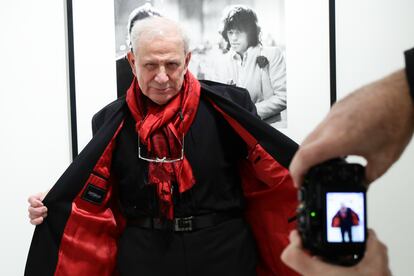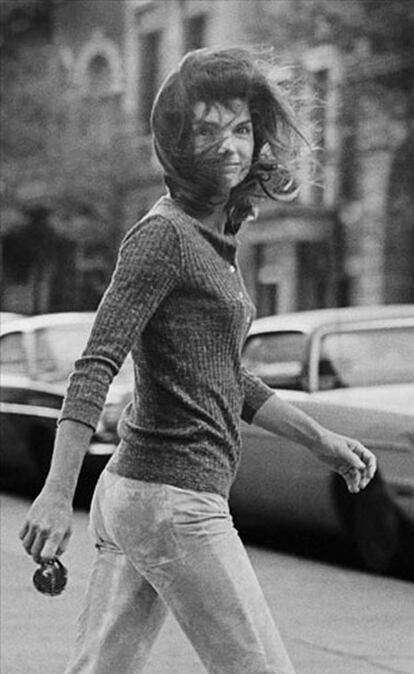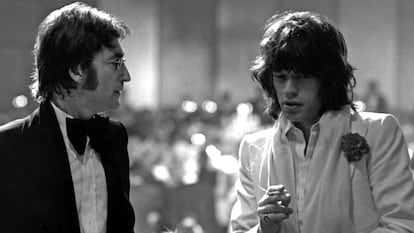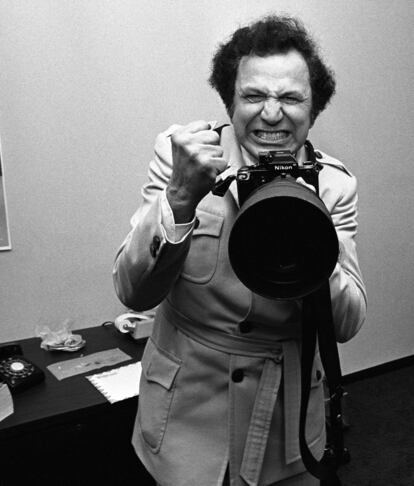Ron Galella, ‘paparazzo extraordinaire,’ dies at 91
The photographer, who snapped candid images of Jacqueline Kennedy, Marlon Brando, Elizabeth Taylor and Sophia Loren, has died of heart failure in New Jersey


Unlike his colleagues who were eager to capture the least flattering angle of Hollywood stars, photojournalist and so-called “paparazzo extraordinaire” Ron Galella, who died Saturday of heart failure at age 91 in New Jersey, sought only naturalness: the inherent humanity, so often hidden by fame, of people shrouded in the aura of dreams. But to achieve such intimate portraits, one had to get close to them. One night in 1973, Galella got so close that actor Marlon Brando, already in the twilight of his impressive career, knocked out five of his teeth with one punch. With a Band-Aid on his lip, bleeding profusely, Galella drove to a hospital, got a few stitches and left to cover another event. Another night he was beaten up by a group of bodyguards sent by actor Richard Burton.
Galella’s tactics were so insistent that America’s widow, Jackie Kennedy, fed up with the photographer’s harassment, obtained a restraining order against him in 1981. The images of Jackie Kennedy in 1971 fleeing from his lens through Central Park – wearing jeans, a sweater and ballerina flats, with her hair in the wind – are in stark contrast to his most famous snapshot: Windblown Jackie. In this image, which he called his own “Mona Lisa,” Jackie Kennedy has her face half turned and looks him in the eyes, with a slight smile – something the photographer considered a triumph. It would become Galella’s most-famous image and was described in 2016 by Time magazine as “one of the most influential photos in history.”

“The stars call me by my name. That’s an honor,” Galella once said. To achieve this level of familiarity, he snuck into places where he was not invited – on one occasion disguising himself as a Greek peasant – and even falsified accreditations, methods that today seem like simple pranks. These tactics were necessary to achieve another of his style goals: to capture candid images of people acting like themselves, without being aware they were being photographed. His intimate photo of John Lennon and Mick Jagger talking during a party is one example of this approach. Bathed in a beautiful diffused light, the image of the two musicians is also a posthumous record: it was one of the last taken before Lennon was murdered.

Faithful to his Italian-American origins, Galella was also a character, a clown capable of making fun of how he was treated by the stars. After his encounter with Marlon Brando, Galella continued to chase the actor through the streets of New York, but as a joke, he wore an American football helmet with jaw protection – a scene that was immortalized in a photograph taken by one of his colleagues. After being ordered to stay away from Jackie Kennedy, he allowed himself to be photographed near her, at an event, wielding a measuring tape to check that he was at the distance required by the restraining order: 25 meters. The design of his Montville residence, where he lived with Betty, his wife and assistant, who died in 2017, was also so over-the-top that it was touted as a possible setting for the TV show The Sopranos. He never lost his impulsive and outspoken attitude, forged by growing up in the Bronx in New York City. It was in that borough, in the basement of his father’s old business, where he developed his photos.
Galella helped forge the public image and legend of stars such as Elizabeth Taylor, Sophia Loren, Paul Newman, Liza Minnelli, Barbra Streisand and Andy Warhol, who described him as his “favorite photographer.” “We have the same social disease,” Galella would reply about their compulsive interest in celebrities. But there were many more who were angered by Galella’s prying lens, which documented the celebrity scene in New York and Hollywood in the 1970s: a blasé Bette Davis; Mick Jagger and then partner Jerry Hall, giving him the middle finger; a wild-eyed Al Pacino; a shy Woody Allen trying to avoid being snapped; and Katherine Hepburn, with black glasses trying to block the camera with her hand. “I hid in the garage and surprised [her] on arrival,” Galella wrote about the image in No Pictures, one of the collections of his work.

From his beginnings as a war photographer, as part of the US Air Force during the Korean War between 1951 and 1955, to his consecration as an artist – with books, exhibitions and work in the best collections in the world – Galella helped shape pop culture with his snapshots. The photographer became a celebrity in his own right, and many stars who once repudiated him would be seen in exhibitions of his work. In 2003, designer and later filmmaker Tom Ford compiled an anthology of his work, The Photographs of Ron Galella. His images were also included in Disco Years, a visual diary of the New York club scene in the 1970s, which was named the best photography book of 2006 by The New York Times. In 2010, HBO released a documentary about his life called Smash His Camera, which won the Directing Award Documentary prize at Sundance Film Festival. The documentary is an interesting portrait of the life and career of Galella, who tried to restore humanity to his subjects by portraying them as normal people.
Tu suscripción se está usando en otro dispositivo
¿Quieres añadir otro usuario a tu suscripción?
Si continúas leyendo en este dispositivo, no se podrá leer en el otro.
FlechaTu suscripción se está usando en otro dispositivo y solo puedes acceder a EL PAÍS desde un dispositivo a la vez.
Si quieres compartir tu cuenta, cambia tu suscripción a la modalidad Premium, así podrás añadir otro usuario. Cada uno accederá con su propia cuenta de email, lo que os permitirá personalizar vuestra experiencia en EL PAÍS.
¿Tienes una suscripción de empresa? Accede aquí para contratar más cuentas.
En el caso de no saber quién está usando tu cuenta, te recomendamos cambiar tu contraseña aquí.
Si decides continuar compartiendo tu cuenta, este mensaje se mostrará en tu dispositivo y en el de la otra persona que está usando tu cuenta de forma indefinida, afectando a tu experiencia de lectura. Puedes consultar aquí los términos y condiciones de la suscripción digital.
More information
Últimas noticias
Most viewed
- Alain Aspect, Nobel laureate in physics: ‘Einstein was so smart that he would have had to recognize quantum entanglement’
- Maps of the US attack on Venezuela: Targets, airspace and deployed fleet
- Oil, gold and rare earth elements: the backdrop to US political tension with Venezuela
- Key points of the military attack on Venezuela: Early morning bombings and a ‘captured’ president
- The US bombing of Venezuela, in pictures










































